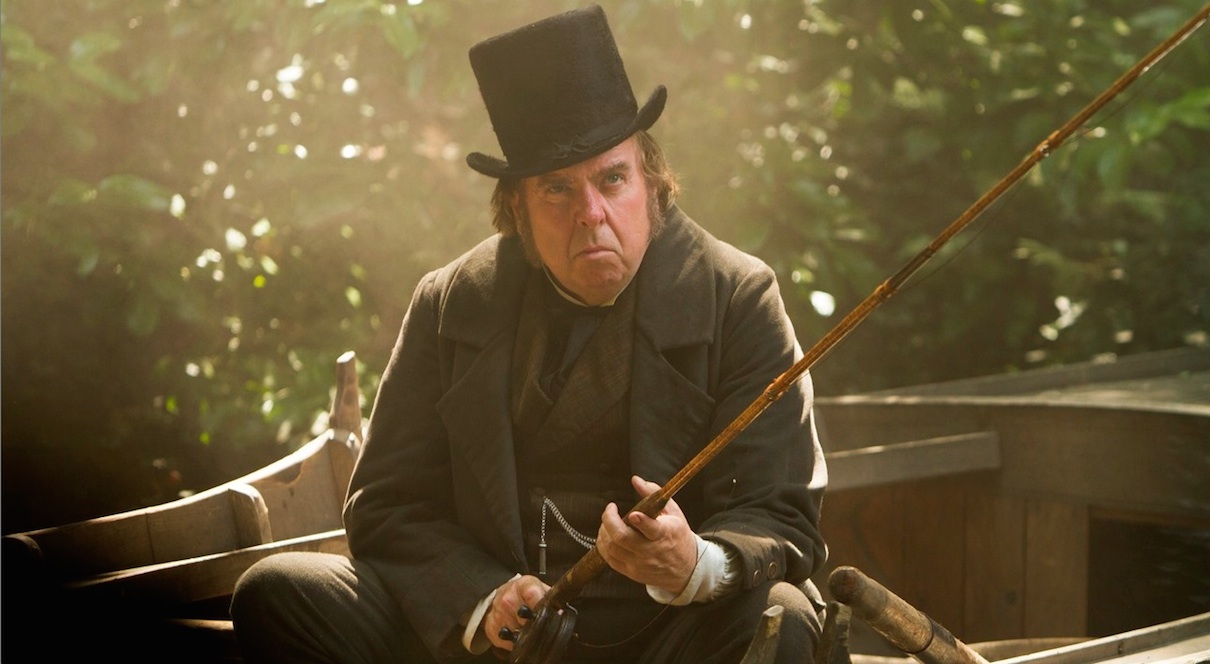
With the DVD release this week of Mike Leigh’s Mr. Turner, about the great 19th century English painter J.M.W. Turner, I thought I would sit down and attempt to tap out an appreciation for it—not a review, exactly, but a sort of fan’s notes for a work of art that moved me more than any painting, play, novel or film this past year, and stayed with me longer than anything other form of expression, too. I saw it twice in one spellbinding week last December–something I have never done for another film, and many scenes live as indelibly in my memory as if I’d actually experienced them. It’s a long and demanding film–its running time is approximately two-and-a-half-hours—yet strangely enough I found myself exhilarated rather than exhausted after that first viewing; I had expected, on second viewing, to be restless but not only was I not squirming in my seat at any point, I had the distinct sensation when it was over that the film, this time around, was somehow shorter.
Mr. Turner was enthusiastically reviewed in many outlets, including all the important ones, but it also disappeared shortly after it hit theaters and was summarily ignored by the Oscars, which can keep a difficult or idiosyncratic or strange film to in the public’s eye a little bit longer, in all the categories that matter. And Mr. Turner is difficult and idiosyncratic and strange, a film that is meant to unsettle and provoke more than to entertain or instruct, that heeds its own dictates and not the conventional demands of an audience, and that gives us characters who force us to pay careful attention in order to find the good in them.
It should tell you something about Mr. Turner that a good friend of mine, an avowed cinephile and sometime admirer of Leigh’s, found the film “unwatchable.” When I asked my friend to elaborate, he immediately sought to qualify his condemnation. He thought it beautifully filmed, a point that is almost not debatable (Leigh and his longtime cinematographer Dick Pope work hard and well to convey the Turner palette, its grayish blues and ochreish yellows, along with the sad wintry light that knifes through so many of his landscapes and scenes at sea). He also wished me to know that he found it tenderly affecting, as when Turner, played by Timothy Spall, visits a prostitute in the wake of his dear father’s death, but also disturbingly affecting, as when Turner hikes up his housekeeper’s dress and with sudden, animalistic lust takes her standing up. The bigger problem was he simply couldn’t stand the title character.
Turner as depicted by Spall, is “despicable—an animal, right down to his grunts of affirmation or no thanks,” my friend wrote after taking in an afternoon matinee. The story, “such as it is,” he added, is an essentially formless mess sprawling over three decades in the artist’s life.
And this appraisal was considerably more kind than that of his date, who midway through the picture threatened to walk out of the theater.
I mention all of that not to turn you off from the film but simply to cement the idea that Mr. Turner is not for everybody (as the son of an artist I admit that I may be more predisposed to like this type of film), and that if you are someone who likes things that are not for everybody, and particularly if you are someone who likes things especially because they are not for everybody, then you ought to rent it and give it a chance.
When I popped the DVD into my Blu-ray player earlier this week, I was reminded again—no, astonished again—by how rich and engrossing an experience Leigh has given us, a complete and utter immersion in another world, in this case a world both like and unlike our own.
Many critics have written about the extreme naturalism of his style, and this is the first thing you are seized with in a Mike Leigh film, the sense that you are not watching performers in action, but rather that the director is working in a documentary mode, subjecting real people to his relentless, sometimes pitiless analysis.
All or Nothing, in which Spall stars as a beset-from-all-sides taxi driver, comes across initially as a character sketch or a slice of life, unspooling as slowly as life itself. Leigh is so patient in advancing his story that you begin to wonder if there is one, or whether the myriad little telling details that anchor us in the grimy, sad world of a south London public housing estate are meant to stand in for a story. For a long while this 2002 film seems to go nowhere, until suddenly and without warning it goes somewhere, and fast, and you realize, as it hurtles to its irrevocable resolution, that this is how life is: an accretion of ordinariness, of the mundane, until someone or something, some event, love, death, tragedy, jars us loose from our dulled complacency.
And All or Nothing was considerably more plotted than 1999’s Topsy Turvy, Leigh’s film about Gilbert and Sullivan, which was not, as it was advertised, a story about the making of The Mikado.” It was a story about making, about the tensions between art and commerce, even between artist and artist, and, above all, between the artist’s need to live in the world and be a part of his time and the great and sometimes straining desire to transcend these needs.
On first and even second viewing, Mr. Turner seemed to me to exist alongside these two films—a story about art and commerce, about belonging and rejecting, the great themes of the second half of Leigh’s career (along with class, which he explores with remarkable subtlety and incisiveness). It was on third viewing that I discovered that it represented something new in the Leigh oeuvre.
The film begins with an opening sequence that is an homage both to Turner (its composition and colors) and to Russian director Andrei Tarkovsky (its slow reveal). A couple of young Dutch women traipsing in a field catch the eye of the cameraman, who tracks them as they walk, pulling back slowly to reveal the artist, Turner, in silhouette on the other side of the river, painting near a windmill. We don’t see Turner’s face. He never faces us. The camera doesn’t dare to disturb him. It is an image of the artist looking, a scene of aesthetic rapture akin to religious ecstasy.
In the next scene, we are plunged into the opposite world, a viscerally vivid market in London. If Saul Bellow is the acknowledged master at rendering faces in print, then Leigh is his equal in film. Here is the 19th-century English working class in all its bestial poverty—the pale, blotchy skin, the brittle, nutrient-deprived hair, the crooked, sugar-decayed teeth. They jostle for position, they fight over the best products, they enact the scrum that is daily life in a society that pits the classes one against another. I’ve seen a lot of market scenes, but never one as raw and vital as this one, as simultaneously riveting and revolting—I don’t think I’ll ever forget the shot of those serenely smiling hogs’ heads with their hairy chinny chin chins. Even more indelible is the image of Turner’s father, played with tender affection by Paul Jesson, shaving them in the next scene in preparation for dinner, a welcome-home feast for the artist, who has gone to Holland to try to understand the northern light that suffuses Rembrandt’s canvases.
On third viewing, I realized, finally, that here was the film in microcosm, in these two juxtaposed scenes. Turner in silhouette exists apart not just from the women strolling by the river—he exists apart from everyone and everything. That silhouette is hauntingly, poetically resonant, an image of his solitariness. His father, on the other hand, is a man of and among the people, a man of his time. He is at ease in the market, which for Leigh is more than just a place to go and buy hogsheads. He makes us see the market as a symbol of the society, of the competitive, material world that the artist, man of spirit, stands apart from. Turner may be in it, but he surely is not of it. The artist’s father, a barber, is a smooth social animal, joking, cajoling, winking, making nice at every turn; Turner possesses none of these skills. Navigating the world and its people is not just a nuisance to him. It seems genuinely to be a monumental and painful task. The one skill he has, if you can even call it that, is to grunt and growl and scowl at people, and he uses it whenever he can’t be bothered, which is nearly always. These grunts and growls are less an expression of contempt toward the people he meets, however, than they are a kind of wordless utterance meant to discourage the inquiries of strangers and keep the world at bay. Art is not just what Leigh’s Turner does. It is his way of being.
One of the problems with knowing a lot about a writer or a director is that the work you have seen or read previously conditions you to respond a certain way to the new work. In that sense, you don’t truly see it. You see what you saw before. Conditioned to see a film about art and money and society, I missed what had seemed, now, to be so obvious to me on third viewing—that Leigh had fashioned above all a story of father and son. Here was the frame I did not think the film had, which meant, then, that it was not the sprawling naturalistic mess that my friend and to a lesser extent I thought it was, but something more shapely and more coherent: an artful artlessness.
Turner’s father is not just his son’s shopper and shaver of hogs. He is his son’s go-between, his buffer, his bouncer. Much has been made, in the press, of the cruelty of Leigh’s Turner toward his estranged daughter, who, in an early, unsettling scene, shows up unannounced at the house one day with her mother and baby. Hectoring Turner in front of his father and housekeeper, the girl’s mother intends to guilt him into supporting the life of his newborn granddaughter. Turner listens—then kicks them out. Point established: He is ruthless, cold, unfeeling. Whether in the interest of his art or simply because he is a callow human being, or both (the film never tips its hand either way), he has turned away from family and responsibility.
He has not, however, rejected his father, with whom he enjoys a relationship that is deep, loving, and kind. Turner’s mother, dead by the time the film opens, is never seen and only glancingly referred to, but she is powerfully present in her absence. The film intimates not only that father and son have grown closer without her but also, and more interestingly, that the artist has turned his father into a kind of mother.
Very early on, Turner and his father exchange a kiss, each man wrapping his arms around the head of the other. Turner does not kiss or hug or even touch the mother of his children, or his daughter or granddaughter. Or the prostitute he visits. Or the generous widow Sophia Booth he eventually moves in with. The most important person in his life is his father. And it is through this relationship that Leigh Turner’s tenderness and vulnerability peek in like a narrow shaft of light through closed curtains, but their tie also constructs the spine of his story, which is not simply a biopic, or a slice of thirty years of the artist’s life and times, as much of the writing about the film has suggested.
Everything that advances the story, everything important in the story, has to do with Turner and his father. Turner’s art took a decisive turn in the final decade of his life, becoming more abstracted and less defined, and anticipating, some art historians have written, the arrival of the Impressionists. Leigh’s film strongly suggests that this turn is the artist’s response to the loss of his father. The clarity of his pastoral and nautical landscapes, with their striking and dramatic shafts of natural light, give way, in the wake of his father’s death, to landscapes marked by muddied colors, fuzzy lines, muted light—a pictorial indistinction that betrays his personal instability and uncertainty.
Early on in the film, Leigh places a scene at a country estate where Turner has gone for the weekend to relax and recharge. Wandering the rooms of the great house one day, the artist comes upon a young woman at the piano playing a piece from Purcell–Dido’s suicide aria from Dido and Aeneas. We watch as this grunting beast of an artist is softened by the delicate melody, and are given to wonder whether he might be falling for her.
He mumbles along to the piece in his rough, sea shanty way, he speaks his regard for it with vulnerable and affecting tenderness, he lingers at the piano with the young woman long after it’s over. But nothing comes of their encounter. I had initially thought that the scene existed to show us how different Turner is in the presence of art, open and embracing and ungrunting. But now I realized that it was also to underscore how emotionally stunted he is, how incapable of acting on his feelings.
Leigh wants us to hold onto this scene and remember it later, after the cataclysm, when Turner, finally, does act.
The cataclysm is his father’s death, an event that devastates but also transforms him as both artist and man. Leigh never shows us Turner’s emotions directly as the artist grapples with the news that his father has died. There are no tears, no public mourning, not even a funeral. In the very next scene, Leigh gives us a visit to a prostitute. Turner is going to drown his sorrows in cheap sex. So we are made to think. And we feel for him.
Except that Turner doesn’t have sex with her. He doesn’t want her body. Or not like that, he doesn’t. He instructs her to lie back on the bed, to stretch her arms out, to turn her head to the side. He Christifies her. This is his mourning—to express his inexpressible suffering by drawing the very emblem of suffering. Here, now, sketching at the foot of the bed of a prostitute in a cheap inn, the son weeps. It’s an extraordinary scene, and all the more so for coming at things indirectly.
His work, from this point on, becomes more emotionally intense, but also more pictorially diffuse. The public, and particularly the Queen, disdain these new pictures; the artist is mocked for the ugliness of his canvases at a theatrical performance.
Wandering the halls of an exhibition one day in advance of opening night, Turner inspects the canvas of a contemporary, John Constable. Constable is applying the finishing touches to the painting, with its odd, garish touches of red throughout. Borrowing the man’s red-tipped brush, Turner applies a thick stroke of red to one of his dark nautical canvases—a smear of blood, right in the center of the picture. His fellow artists think he has gone mad, that the criticism has unmanned him. Why else would he deface his own canvas?
Here’s why else: because what matters to Turner now is not the depiction of things as they are but rather how those things feel to him; not beauty, but truth, emotional truth. He bleeds for his father, without his father, because of his father. And so he undertakes to disturb the placid surface of his canvases, stabbing at them and making them bleed. In this same spirit, he later lashes himself to the mast of a ship, letting the winds whip him and spray him with foam to understand what it feels like to be stranded at sea.
This seeking out of emotional truth is a sign of growth for Turner the character, and Leigh allows us to see that this thawing, this turning, is what leads him to fall in love with Sophia Booth. Only now, after his father’s death—only with these earnest and fumbling expressions of indirect emotion—can Turner love. Only now does he have the capacity.
Booth elicits from Turner only his second smile of the movie, the first since his father died. By picture’s end, dividing his time between city and seaside in cozy domesticity with Booth, he looks to be, if not happy, then at least contented. His reputation as an artist is towering, and secure—even the doctor who visits his bedside recognizes that his name will endure. But the arc of the story is not to show us how Turner the artist cemented his stature. It is to show us how Turner opened himself up to emotion and affected a breakthrough in consciousness—his own and ours.
On his deathbed, the camera pulls back from the artist’s bloated, stunned face to show us his hands, the hands that wrought some of the most fascinating, important paintings of the past three hundred years. But wait—what is this? A ring on his finger. The jewel is ruby. No no, not ruby. Darker, measurably darker. The red of blood.
OtherWise is Washingtonian food critic Todd Kliman’s new weekly column. Sometimes it will be about food.














